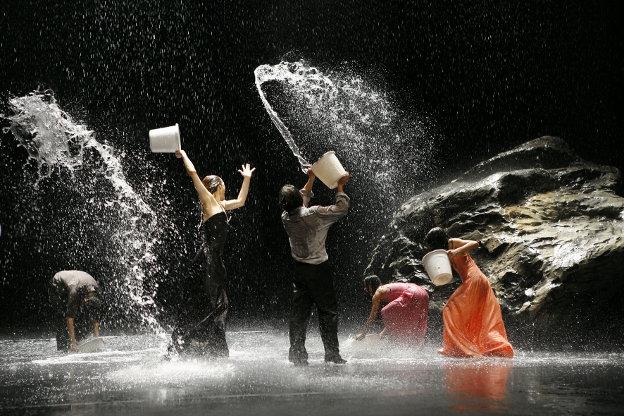Showing as a revival alongside Two Cigarettes In the Dark, Vollmond, meaning full moon, was first performed in 2006. The company of twelve dancers offered a chair for the audience’s ‘ghost to have seat too’, embodying our alter-ego on stage. They filled a bleak, barren, landscape with a series of sketches drawing on social relationships and behaviour with a mixture of honesty and satire, juxtaposing wooden emotion with frenzied passion. Short sequences between pairs were played out over and over until their meaning fractured and their futility prospered. These scenes, interspersed between longer sequences, structured the piece by suggesting social interactions (such as flirtatious power games) as undercurrents of the dances, preventing the intensity and repetition of the piece from becoming monotonous.
All this played out beneath a looming rock upon which a figure indicative of Auguste Rodin’s The Thinker could occasionally be spotted, drawing attention to the reflection of human behaviour, often at cross-purposes, often submissive to the dominating dancer. Direct gaze, interaction with the audience and an often lit auditorium invited inward reflection on the audience’s own behaviour.
Water ran constantly throughout the piece pouring from bottles, overflowing from wine glasses, spurting from mouths or flooding the stage in a monsoon. It was the sustenance of life in a barren landscape as the dancers preened and cleansed like birds in a birdbath, washed, drank and swam. The acting-out of their needs for affection, attention or control seemed to cleanse both them and the audience of an almost obsessive and compulsive need to repeat urges and habits.
The first female solo in the water gave the piece its identity, drawing from the sketches of human behaviour expressed by the characters through speech and pastiche and extracting and abstracting their motifs into a ritual dance and flagellation. She revelled in the water with intricate micro-gestures from epaulment in the shoulders to the position of each fingertip juxtaposed with slapping and wringing of the body and continuous rebounds, expanding to Catherine wheels of arms, hair and water engulfing the world around her. Her warm-orange evening dress glowed in the downpour, the stage and dancer becoming more and more energised as the expansive landscape became saturated with an equally expansive range of movement. A series of similar solos and a duet from the female performers followed at intervals throughout the piece verging between frustration, desperation, exultation and exhaustion, as the delicate sheet of water fell with more rigour and weight.
The tension between beauty and the grotesque was balanced by the shifting juxtapositions running through the piece. Young and old, life and death, emptiness and excess alluded to what it is to be alive and why we do what we do. From bathing on a lino with allusions of the pieta, drawing chalk around the dancer’s figure, or turning the act of kissing into a barrage of pursed woodpecker pecks, intricate motifs and gestures speckled the piece with a layer of delicacy and complexity. They drew together the recurring themes and behaviours of the characters towards a finale of individual, passion-drenched drama culminating in explosive entrances and exits in a furore of water flying from every limb and extension to the point of exhaustion. A ritual of the playing out of life, of basic human need and of homage to the late Pina Bausch,Vollmond’s reflection on human interaction tackled dark ideas with humour and magnificence.


